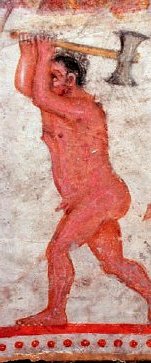|
Zalmoxianism
Zalmoxianism () or Zamolxianism () is a Neopagan movement in Romania which promotes the rebuilding of an ethnic religion and spirituality of the Romanians through a process of reconnection to their ancient Dacian and Thracian roots. The religion takes its name from Zalmoxis or Zamolxe, at the same time the name of the primordial god and the archetype of the enlightened man in Paleo-Balkan mythology. Scholars Bakó and Hubbes (2011) have defined Zalmoxianism, like the other ethnic religious revivals of Europe, as a reconstructionist ethno-paganism. Origins The reconstruction of ancient Dacian and Thracian religion and mythology has been strictly connected with the field of dacology. Amongst contemporary supporters of Zalmoxianism, the emigrant dacologist Octavian Sărbătoare even proposed to make it the official religion of Romania. Organisations The Gebeleizis Society The "Gebeleizis Society" ( Romanian: ''Societatea Gebeleizis''), though far from being the only Zalmoxia ... [...More Info...] [...Related Items...] OR: [Wikipedia] [Google] [Baidu] |
Slavic Neopaganism
The Slavic Native Faith, commonly known as Rodnovery and sometimes as Slavic Neopaganism, is a modern Paganism, modern Pagan religion. Classified as a new religious movement, its practitioners hearken back to the Slavic paganism, historical belief systems of the Slavs, Slavic peoples of Central and Eastern Europe, though the movement is inclusive of external influences and hosts a variety of currents. "Rodnovery" is a widely accepted self-descriptor within the community, although there are Rodnover organisations which further characterise the religion as Vedism, Orthodoxy, and Old Believers, Old Belief. Many Rodnovers regard their religion as a faithful continuation of the ancient beliefs that survived as a folk religion or a conscious "double belief" following the Christianisation of the Slavs in the Middle Ages. Rodnovery draws upon surviving historical and archaeological sources and folk religion, often integrating them with non-Slavic sources such as Hinduism (becaus ... [...More Info...] [...Related Items...] OR: [Wikipedia] [Google] [Baidu] |
Zalmoxis
Zalmoxis is a divinity of the Getae and Dacians (a people of the lower Danube), mentioned by Herodotus in his ''Histories'' Book IV, 93–96, written before 425 BC. Said to have been so called from the bear's skin (ζάλμος) in which he was clothed as soon as he was born. According to Jordanes' ''Getica'', he was a learned philosopher, before whom two other learned men existed, by the names of Zeuta and Deceneus. Herodotus Herodotus writes about Zalmoxis in book 4 of his ''Histories'': 93. ... the Getae are the bravest of the Thracians and the most just. 94. They believe they are immortal forever living in the following sense: they think they do not die and that the one who dies joins Zalmoxis, a divine being; some call this same divine being Gebeleizis. Every four years, they send a messenger to Zalmoxis, who is chosen by chance. They ask him to tell Zalmoxis what they want on that occasion. The mission is performed in the following way: men standing there for tha ... [...More Info...] [...Related Items...] OR: [Wikipedia] [Google] [Baidu] |
Paleo-Balkan Mythology
Paleo-Balkan mythology is the group of religious beliefs held by Paleo-Balkan-speaking peoples in ancient times, including Illyrian, Thracian and Dacian mythologies. Horseman The horseman was a common Palaeo-Balkan hero. The original Palaeo-Balkan word for 'horseman' has been reconstructed as ''*Me(n)zana-'', with the root ''*me(n)za-'' 'horse'. It is based on evidence provided by: * Albanian: ''mëz'' or ''mâz'' 'foal', with the original meaning of 'horse' that underwent a later semantic shift 'horse' > 'foal' after the loan from Latin ''caballus'' into Albanian ''kalë'' 'horse'; the same root is also found in Albanian: ''mazrek'' ' horse breeder'; p. 45. * Messapic: ''menzanas'', appearing as an epithet in '' Zis Menzanas'', found in votive inscriptions, and in ''Iuppiter Menzanas'', mentioned in a passage written by Festus in relation to a Messapian horse sacrifice; * Romanian: ''mînz''; * Thracian: ΜΕΖΗΝΑ̣Ι ''mezēnai'', found in the inscription of the Duv ... [...More Info...] [...Related Items...] OR: [Wikipedia] [Google] [Baidu] |
Neopaganism
Modern paganism, also known as contemporary paganism and neopaganism, spans a range of new religious movements variously influenced by the Paganism, beliefs of pre-modern peoples across Europe, North Africa, and the Near East. Despite some common similarities, contemporary pagan movements are diverse, sharing no single set of beliefs, practices, or religious texts. Religious studies, Scholars of religion may study the phenomenon as a movement divided into different religions, while others study neopaganism as a decentralized religion with an array of Religious denomination, denominations. Adherents rely on Christianization, pre-Christian, folkloric, and ethnographic sources to a variety of degrees; many of them follow a spirituality that they accept as entirely modern, while others claim to adhere to Prehistoric religion, prehistoric beliefs, or else, they attempt to revive indigenous religions as accurately as possible. List of modern pagan movements, Modern pagan movements are ... [...More Info...] [...Related Items...] OR: [Wikipedia] [Google] [Baidu] |
Extremism
Extremism is "the quality or state of being extreme" or "the advocacy of extreme measures or views". The term is primarily used in a political or religious sense to refer to an ideology that is considered (by the speaker or by some implied shared social consensus) to be far outside the mainstream attitudes of society. It can also be used in an economic context. The term may be used pejoratively by opposing groups, but is also used in academic and journalistic circles in a purely descriptive and non-condemning sense. Extremists' views are typically contrasted with those of moderates. In Western countries, for example, in contemporary discourse on Islam or on Islamic political movements, the distinction between extremist and moderate Muslims is commonly stressed. Political agendas perceived as extremist often include those from the far-left politics or far-right politics, as well as radicalism, reactionism, chauvinism, fundamentalism, and fanaticism. Definitions P ... [...More Info...] [...Related Items...] OR: [Wikipedia] [Google] [Baidu] |
Protochronism
Dacianism is a Romanian term describing the tendency to ascribe, largely relying on questionable data and subjective interpretation, an idealised past to the country as a whole. While particularly prevalent during the regime of Nicolae Ceaușescu, its origin in Romanian scholarship dates back more than a century. The term refers to perceived aggrandising of Dacian and earlier roots of today's Romanians. This phenomenon is also pejoratively labelled "Dacomania" or "Dacopathy" or sometimes "Thracomania", while its proponents prefer "Dacology". The term protochronism (anglicised from the , from the Ancient Greek terms for "first in time"), originally coined to refer to the supposed pioneering character of the Romanian culture, is sometimes used as a synonym. Overview In this context, the term makes reference to the trend (noticed in several versions of Romanian nationalism) to ascribe a unique quality to the Dacians and their civilisation. Dacianists attempt to prove either that ... [...More Info...] [...Related Items...] OR: [Wikipedia] [Google] [Baidu] |
Hungarian Neopaganism
Hungarian Neopaganism, or the Hungarian Native Faith ( Hungarian: ''Ősmagyar vallás''), is a modern Pagan new religious movement aimed at representing an ethnic religion of the Hungarians, inspired by taltosism (Hungarian shamanism), ancient mythology and later folklore. The Hungarian Neopaganism movement has roots in 18th- and 19th-century Enlightenment and Romantic elaborations, and early-20th-century ethnology. The construction of a national Hungarian religion was endorsed in interwar Turanist circles (1930s–1940s), and, eventually, Hungarian Neopagan movements blossomed in Hungary after the fall of the Soviet Union. The boundaries between Hungarian Neopagan groups often relate to differing beliefs relating to the ethnogenesis of the Hungarians, generally believed to have originated on the Asian Steppe. Some Hungarian Neopaganistic groups sought to reconstruct their native faith based upon contemporary ideas about Scythian, Persian, and Sumerian religions and culti ... [...More Info...] [...Related Items...] OR: [Wikipedia] [Google] [Baidu] |
Völkisch Movement
The ''Völkisch'' movement ( , , also called Völkism) was a Pan-Germanism, Pan-German Ethnic nationalism, ethno-nationalist movement active from the late 19th century through the dissolution of the Nazi Germany, Third Reich in 1945, with remnants in the Federal Republic of Germany afterwards. Erected on the idea of "blood and soil", inspired by the one-body-metaphor (''Volkskörper'', "ethnic body"; literally "body of the people"), and by the idea of naturally grown communities in unity, it was characterized by organicism, racialism, populism, agrarianism, romantic nationalism and – as a consequence of a growing exclusive and ethnic connotation – by antisemitism from the 1900s onward. ''Völkisch'' nationalists generally considered the Jews to be an "alien people" who belonged to a different ''Volk'' ("race" or "folk") from the Germans. The ''Völkisch'' movement was not a homogeneous set of beliefs, but rather a "variegated sub-culture" that rose in opposition to the soci ... [...More Info...] [...Related Items...] OR: [Wikipedia] [Google] [Baidu] |
Nazism
Nazism (), formally named National Socialism (NS; , ), is the far-right totalitarian socio-political ideology and practices associated with Adolf Hitler and the Nazi Party (NSDAP) in Germany. During Hitler's rise to power, it was frequently referred to as Hitler Fascism () and Hitlerism (). The term " neo-Nazism" is applied to other far-right groups with similar ideology, which formed after World War II, and after Nazi Germany collapsed. Nazism is a form of fascism, with disdain for liberal democracy and the parliamentary system. Its beliefs include support for dictatorship, fervent antisemitism, anti-communism, anti-Slavism, anti-Romani sentiment, scientific racism, white supremacy, Nordicism, social Darwinism, homophobia, ableism, and the use of eugenics. The ultranationalism of the Nazis originated in pan-Germanism and the ethno-nationalist '' Völkisch'' movement which had been a prominent aspect of German ultranationalism since the late 19th centu ... [...More Info...] [...Related Items...] OR: [Wikipedia] [Google] [Baidu] |
Paganism
Paganism (, later 'civilian') is a term first used in the fourth century by early Christians for people in the Roman Empire who practiced polytheism, or ethnic religions other than Christianity, Judaism, and Samaritanism. In the time of the Roman Empire, individuals fell into the pagan class either because they were increasingly rural and provincial relative to the Christian population, or because they were not '' milites Christi'' (soldiers of Christ).J. J. O'Donnell (1977)''Paganus'': Evolution and Use, ''Classical Folia'', 31: 163–69. Alternative terms used in Christian texts were '' hellene'', '' gentile'', and '' heathen''. Ritual sacrifice was an integral part of ancient Greco-Roman religion and was regarded as an indication of whether a person was pagan or Christian. Paganism has broadly connoted the "religion of the peasantry". During and after the Middle Ages, the term ''paganism'' was applied to any non-Christian religion, and the term presumed a belief in fal ... [...More Info...] [...Related Items...] OR: [Wikipedia] [Google] [Baidu] |
Anti-Christian Sentiment
Anti-Christian graffiti from the Alexamenos graffito">Alexamenos worships his god.") Anti-Christian sentiment, also referred to as Christianophobia or Christophobia, is the fear, hatred, discrimination, or prejudice against Christians and/or aspects of the Christian religion's practices. These terms encompass "every form of discrimination and intolerance against Christians". The presence of anti-Christian sentiment has frequently led to the persecution of Christians throughout history. Antiquity Evidence shows that anti-Christian sentiment was already present as early as the Roman Empire during the first century AD. The steady growth of the Christian movement was viewed with suspicion by both the authorities and the people of Rome leading to the persecution of Christians in the Roman Empire. During the second century, Christianity was viewed as a negative movement in two ways: both due to accusations made against adherents of the Christian faith in accordance with the principle ... [...More Info...] [...Related Items...] OR: [Wikipedia] [Google] [Baidu] |
Telegram (software)
Telegram, also known as Telegram Messenger, is a Cloud computing, cloud-based, Cross-platform software, cross-platform, social media and instant messaging (IM) service. It was originally launched for iOS on 14 August 2013 and Android on 20 October 2013. It allows users to exchange messages, share media and files, and hold private and group voice or Videotelephony, video calls as well as public Live streaming, livestreams. It is available for Android (operating system), Android, iOS, Microsoft Windows, Windows, macOS, Linux, and web browsers. Telegram offers end-to-end encryption in voice and video calls, and optionally in private chats if both participants use a Mobile_device, mobile device. Telegram also has social networking features, allowing users to post Story (social media), stories, create large public groups with up to 200,000 members, or share one-way updates to unlimited audiences in so-called channels. Telegram was founded in 2013 by Nikolai Durov, Nikolai and Pavel ... [...More Info...] [...Related Items...] OR: [Wikipedia] [Google] [Baidu] |






